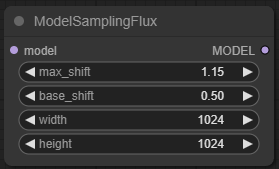ModelSamplingFlux
Because sometimes “just letting the model do its thing” isn’t good enough.
🧠 What Is This Node?
The ModelSamplingFlux node is a precision tool in ComfyUI designed to let you grab the wheel of your model’s sampling process and steer it toward exactly the kind of results you want. Instead of relying solely on the model’s default behavior, you can directly adjust shift values and dimensions to fine-tune how the model interprets and generates output.
Think of it as a way to whisper in your model’s ear, “Yes, do that… but also, maybe, a little more this way.”

💡 Real-World Use-Cases
This node is perfect for scenarios where even the smallest sampling tweaks can lead to massive changes in visual output quality or style:
- High-precision image generation – Nudge outputs toward a more cohesive style or composition.
- Experimental art workflows – Create subtle or extreme variations by changing shift ratios.
- Matching reference proportions – Enforce width/height for consistent batch renders.
- Controlled randomness – Adjust max/base shifts to allow for variability without losing structure.
⚙️ Node Inputs & Parameters
Below is a detailed breakdown of every field, what it expects, why it exists, and what happens if you decide to “see what happens” when you max it out.
| Field | Type | Example | Description |
|---|---|---|---|
| model | Model | MyModel | The primary model this node will adjust. Must be a compatible diffusion/Flux-based model. Passing the wrong type here will result in errors, weird results, or both. |
| max_shift | Float | 1.15 | The maximum allowed adjustment to the sampling process. Higher values mean greater deviation from the model’s default path. Too high and you might get unplanned chaos. |
| base_shift | Float | 0.5 | The starting offset for the sampling shift. Works in tandem with max_shift to control overall sampling drift. Set it to 0 for pure default sampling; raise it to push the model toward more variation. |
| width | Int | 1024 | The horizontal resolution (in pixels) for sampling. This doesn’t just affect output size—it can change detail distribution and resource usage. |
| height | Int | 1024 | The vertical resolution for sampling. Must be compatible with your model’s architecture (multiples of 8/64 depending on the model). |
⚙️ Node Output
| Output | Type | Description |
|---|---|---|
| MODEL | Model | A modified version of your input model with sampling behavior adjusted according to your parameters. This is now ready to be used in downstream nodes like KSampler, FluxGuidance, or Flux.1 Kontext Image Edit. |
🛠️ Workflow Setup & Best Practices
Recommended Position in Workflow:
Place ModelSamplingFlux after loading your base model but before running any samplers or guidance nodes. This ensures all subsequent nodes operate on your fine-tuned sampling rules.
Typical Setup Flow:
- Load your model (
Load Diffusion Modelor equivalent). - Apply ModelSamplingFlux with your chosen shift/dimension settings.
- Feed into a sampler (
KSampler,FluxGuidance, etc.). - Render your output with desired prompts and conditioning.
🧪 Prompting Tips
- If you’re increasing max_shift, consider adding more descriptive prompt details to keep the image coherent.
- Large width/height combos with big shifts can result in “artistic” glitches—sometimes gold, sometimes garbage.
- Use base_shift as a subtle steering wheel rather than a sledgehammer.
🔥 What-Not-to-Do-Unless-You-Want-a-Fire
- Setting
max_shiftabsurdly high without a reason. This can result in outputs that look like your model had a nervous breakdown. - Forgetting your model’s dimension constraints. Many models expect dimensions in multiples of 8 or 64. Ignoring this will produce errors.
- Using incompatible models. Flux-specific nodes may not play nicely with every checkpoint—test before committing to a workflow.
⚠️ Known Issues
- Over-shifting can cause loss of subject fidelity.
- Certain combinations of width/height may increase VRAM usage significantly.
- Not all model architectures respect shift adjustments equally—results can vary between checkpoints.
📝 Final Notes
The ModelSamplingFlux node is not about replacing your sampler—it’s about prepping your model to respond differently before the sampler even does its thing. Think of it as setting the stage: the sampler is the actor, but ModelSamplingFlux is the director telling them which mood to bring.
If you want predictable, repeatable results—keep shifts low. If you’re chasing creative chaos—crank them up and see what happens.